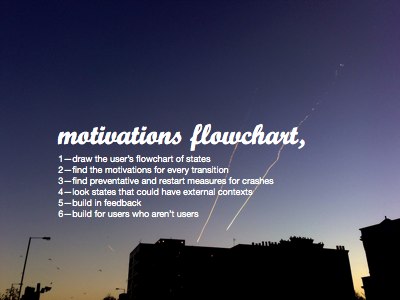Movement
Let me summarise the motivations flowchart approach:
1. Draw the service as a motivations flowchart between user states. The user is a machine for running the service
2. Look at every state transition and find the motivations
3. Look for crash and freeze halting states, and find preventative and restart transitions for each
4. Look for states that aren’t tied explicitly to your application, and see whether there are alternative contexts in which to encounter your user
So the corollary of this is that what you’re designing shouldn’t have features that aren’t required by any of these states. It was really good to hear Indi Young this morning saying that, that you should cull features not matched by elements of the mental models she was discussing.
Point 5 is build in feedback. Now I haven’t talked about the notion of feedback. Feedback is the idea that the system needs to monitor itself because it can adapt and learn, you know. Since the system, in this case, is mainly the user, that means the user needs to be given data about their own behaviour, in order to avoid weird unwanted failure modes. [Like oscillatory usages.]
Interpret this as you will – it could mean that everyone is in charge of their attention data – but I take it to mean that people should see what transitions they’re making and how that changes over time. So in the case of the todo list manager, the user should see how many tasks they’re adding day by day, how many they’re completing, the size of the inbox and so on.
Of course, whatever measure you give, people will attempt to maximise it. That’s just basic psychology.
But I’ve used an email system that represented to me my email behaviour over time, and it definitely helped me keep to a moderate behaviour, to not binge on my inbox and then ignore it for a week, you know, that kind of behaviour. So that’s the role of feedback.
My last point, build for users who aren’t users, is really a reminder that the flowchart has to include the state of users who haven’t even heard of your service yet. How are they going to find you? Are there some small, self-contained loops they can cycle round without bothering to sign up for an account? Is there anything the more dedicated users can be induced to produce in order to mobilise non-users and get them to sign up?
This is a generalisation of the idea of Hotmail tagging the bottom of outgoing emails with “hotmail.com” when they started, to advertise themselves, and YouTube and others allowed videos to be embedded in blogs so non-users get exposure and usefulness to. Anyway, just a reminder to design for the people who don’t know you yet too.
